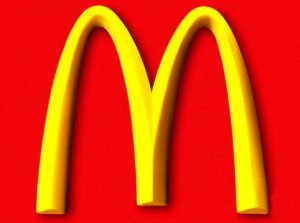 First, it happened at Wal-Mart. Then it was employees at numerous NYC McDonald’s staging a one-day strike.
First, it happened at Wal-Mart. Then it was employees at numerous NYC McDonald’s staging a one-day strike.
Both groups of strikers were advocating for better wages, health care benefits, and the ability to organize. The typical striker makes less than $8/hour. At approximately $1,280 a month, before taxes, if they can get full time hours, these workers will make just around $15,000 a year. This is a few hundred dollars more than the Federal Poverty Guidelines for an individual. Employees of both organizations report being encouraged to supplement their wages with governmental assistance programs.
Wal-Mart and McDonalds are among two of the richest brands in the world. Wal-Mart, the world’s largest brand, reported an increase in global profits in 2011, while McDonald’s dominated the fast food sector with $24,074 million in revenues.
The disparity between the two group’s financial situations is readily apparent: the employers are fabulously wealthy, while the employees are perpetually teetering on the edge of destitution. Is this situation ultimately sustainable? Let’s consider the question from a humanistic perspective.
What Makes Someone Go To McDonalds?
McDonald’s may be the dominant player in the fast food industry, but they’re hardly the only game in town. Even the smallest municipalities generally offer a suite of fast food dining options: Pizza Hut, Subway, Taco Bell and KFC are nearly as ubiquitous as the Golden Arches. Given the choice, why do people decide that they want to eat at McDonald’s. What makes the chain so popular?
The principals of Brand Modeling teach us that an organization’s best customers (the Brand Lovers who loyally return to an establishment time and time again, doing a significant amount of business, while enthusiastically and spontaneously promoting the brand to their family and friends) are those who feel that the organization’s values and vision are in alignment with their own worldview. McDonald’s, which has spent decades urging customers to ‘Come as you are’ with a diverse rainbow of faces saying “I’m loving it” has done an effective job convincing the public that their restaurant is a place where they’d feel welcomed and valued just as they are.
The introduction of labor problems into the picture creates a tension in the relationship McDonalds has with its best customers. It is very easy for McDonald’s customers to identify with McDonald’s employees: many of the people who visit McDonald’s most often are suffering disproportionately from the economic downturn. The same can be said for Wal-Mart’s customers. The customer sees themselves as having more in common with the employee than the employer, and that sense of commonality can have an economic impact, if it becomes clear that the employees are being mistreated or dealt with in bad faith.
Truth In Humor: Monty Python: The People Are Revolting
In an organization that uses a humanistic approach, it is recognized that all parties to a company’s success have needs and wants that must be satisfied. Employees that are worried about food security, the ability to pay for housing, or how they’ll buy their children’s school clothes are not employees who are capable of delivering a top notch performance for the organization. Cost-containment through excessively low wages inevitably results in a situation where performance and customer satisfaction are compromised.
Organizations have the choice between deciding exactly how much quality they’re willing to sacrifice in order to keep costs low, or explore the increase in motivation and performance that would accompany a more complete meeting of their employee’s basic needs. The humanistic approach would favor the latter. Ultimately, this is the only sustainable option over the long term. Employees who have their needs met in a satisfying fashion are not employees who strike in a highly visible fashion, endangering the strength of the customer-brand bond. Putting customers first means being willing to listen to and be responsive to your employees.
